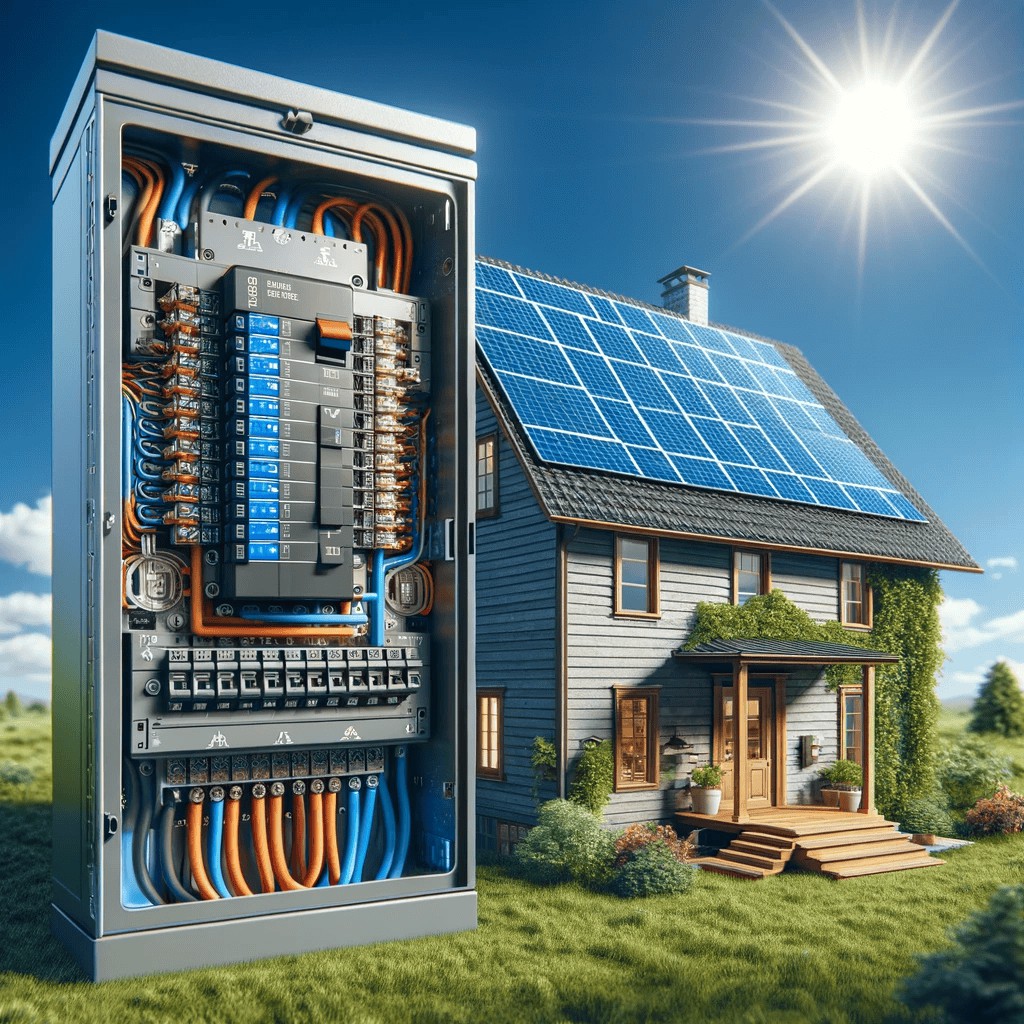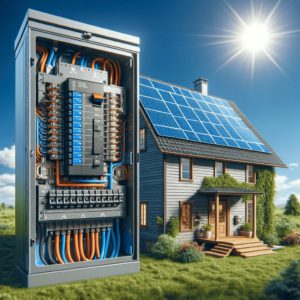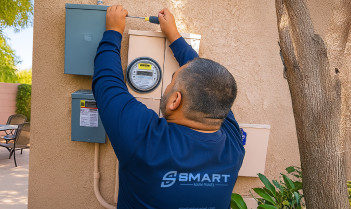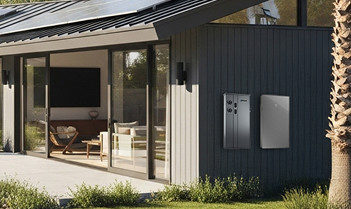
Date
Understanding the Importance of Derating Main Breaker for Solar Systems
Understanding the importance of derating the main breaker for solar systems is crucial for ensuring the safety and optimal performance of the system. Derating refers to the practice of reducing the maximum current-carrying capacity of the main breaker due to various factors such as ambient temperature, conductor size, continuous load, and voltage drop. This article will explore the function of a main breaker, the components and working principle of solar systems, and the reasons for derating the main breaker. It will also discuss the factors that affect derating, the calculation of the derated main breaker size, and the code requirements for derating. Finally, it will highlight the benefits of properly derating the main breaker, including enhanced safety, prevention of overheating, and optimal performance.

Key Takeaways
- Derating the main breaker is crucial for the safety and optimal performance of solar systems.
- Factors such as ambient temperature, conductor size, continuous load, and voltage drop affect the derating of the main breaker.
- The derated main breaker size can be calculated using a derating factor.
- Code requirements, such as those outlined in the National Electrical Code (NEC) and local building codes, must be followed when derating the main breaker.
- Properly derating the main breaker enhances safety, prevents overheating, and ensures optimal performance of the solar system.
What is a Main Breaker?
Function of a Main Breaker
A main breaker is a crucial component of an electrical system. It serves as a safety device that protects the system from overloads and short circuits. When the current flowing through the system exceeds the rated capacity, the main breaker trips and interrupts the flow of electricity. This helps prevent damage to the system and reduces the risk of electrical fires.
In addition to its protective function, the main breaker also allows for convenient control of power distribution. It can be used to turn off the entire electrical system, providing a means to isolate the system for maintenance or in case of emergencies.
To summarize, the main breaker plays a dual role in an electrical system: protecting against overloads and short circuits, and providing control over power distribution.
Types of Main Breakers
Main breakers can be classified into several types based on their design and functionality. The most common types include standard circuit breakers, ground fault circuit interrupters (GFCIs), and arc fault circuit interrupters (AFCIs).
- Standard circuit breakers are designed to protect electrical circuits from overloads and short circuits. They trip when the current exceeds a certain limit.
- GFCIs are specifically designed to protect against electrical shock. They monitor the flow of current and trip when an imbalance is detected.
- AFCIs are designed to detect and prevent electrical fires caused by arcing faults. They monitor the circuit for abnormal arcing conditions and trip to interrupt the flow of electricity.
Understanding Solar Systems
Components of a Solar System
A solar system consists of several key components that work together to generate electricity. These components include a solar array, racking and mounting equipment, inverters, a disconnect switch, and, optionally, a solar battery. The solar array is made up of multiple solar panels that capture sunlight and convert it into DC electricity. The racking and mounting equipment securely holds the solar panels in place and ensures optimal sun exposure. The inverters convert the DC electricity generated by the solar panels into AC electricity that can be used to power electrical devices. The disconnect switch allows the system to be safely disconnected from the grid or other power sources. Additionally, a solar battery can be included in the system to store excess electricity for use during periods of low sunlight or power outages.
Working Principle of Solar Systems
The working principle of solar systems involves the conversion of sunlight into electricity through the use of photovoltaic cells. These cells are made up of semiconductor materials that generate an electric current when exposed to sunlight. The generated electricity is then stored in batteries or fed into the main power grid. Solar systems are a sustainable and renewable source of energy that can help reduce reliance on fossil fuels.
Importance of Derating Main Breaker
Definition of Derating
Derating is the process of reducing the current-carrying capacity of a main breaker to ensure safe operation. It is an essential step in designing and installing solar systems to prevent overheating and potential hazards. By derating the main breaker, the system can handle the continuous load and voltage drop without exceeding its limits.
Reasons for Derating Main Breaker
There are several reasons why derating the main breaker is important for solar systems. One of the main reasons is to ensure the safety and reliability of the system. By derating the main breaker, the system can handle the maximum load without tripping or overheating. This is especially important in areas with high ambient temperatures or where the system is subjected to continuous heavy loads. Another reason for derating the main breaker is to prevent voltage drop. When the main breaker is not properly derated, it can lead to voltage drop, which can affect the performance of the solar system.
Factors Affecting Derating Main Breaker
Ambient Temperature
The ambient temperature refers to the temperature of the surrounding environment where the solar system is installed. It plays a crucial role in the derating of the main breaker. High ambient temperatures can cause the main breaker to heat up, leading to potential overheating and safety hazards. Therefore, it is important to consider the ambient temperature when derating the main breaker.
Conductor Size
The conductor size is an important factor to consider when derating the main breaker for a solar system. The conductor size refers to the diameter or cross-sectional area of the wire used to carry electrical current. It is crucial to choose the appropriate conductor size to ensure the safe and efficient operation of the solar system. Using a conductor that is too small can result in overheating and potential fire hazards, while using a conductor that is too large can lead to unnecessary costs and inefficiencies.
Continuous Load
Continuous Load
A continuous load is a load that operates for three hours or more. In a solar system, continuous loads can include appliances such as refrigerators, air conditioners, and water heaters. These loads require a constant supply of electricity and can put a strain on the main breaker if not properly derated.
To ensure the main breaker can handle the continuous load, it is important to derate the breaker based on the specific requirements of the load. This involves calculating the derating factor and determining the appropriate size for the derated main breaker.
Derating the main breaker for continuous loads is crucial to prevent overheating and ensure the safety and optimal performance of the solar system.
Voltage Drop
Voltage drop refers to the decrease in voltage that occurs as current flows through a conductor. It is an important consideration in solar systems as excessive voltage drop can lead to inefficient operation and potential damage to equipment. To ensure optimal performance, it is recommended to limit the voltage drop to a maximum of 3% of the operating voltage for most PV system circuits. This industry best practice helps to minimize power loss and maintain the desired voltage levels throughout the system.
Calculating Derated Main Breaker Size
Derating Factor
Derating factor is a crucial parameter in determining the size of the derated main breaker for a solar system. It is a multiplier that is applied to the rated current of the main breaker to account for various factors that can affect its performance. The derating factor takes into consideration the ambient temperature, conductor size, continuous load, and voltage drop. By properly calculating the derated main breaker size, the solar system can operate safely and efficiently.
Calculating Derated Main Breaker Size
Calculating the derated main breaker size is an important step in designing a solar system. The derating factor is used to adjust the main breaker size based on various factors such as ambient temperature, conductor size, continuous load, and voltage drop. The derating factor is typically provided by the manufacturer and is used to determine the maximum current that the main breaker can safely handle. To calculate the derated main breaker size, multiply the derating factor by the maximum current rating of the solar system. This will ensure that the main breaker is properly sized to handle the load of the solar system.
Code Requirements for Derating Main Breaker
National Electrical Code (NEC) Guidelines
The National Electrical Code (NEC) provides guidelines for derating main breakers in solar systems. These guidelines ensure the safe and efficient operation of the system. It is important to follow the NEC guidelines to prevent overloading and overheating of the main breaker. The NEC guidelines take into account factors such as ambient temperature, conductor size, continuous load, and voltage drop.
Local Building Codes
Local building codes play a crucial role in the installation and operation of solar systems. These codes are established by local authorities to ensure the safety and compliance of solar installations with the specific requirements of the region. They cover various aspects such as the placement of solar panels, electrical wiring, grounding, and interconnection with the utility grid. Adhering to local building codes is essential to avoid potential hazards and legal issues. It is important to consult with local authorities or hire a professional solar installer who is familiar with the local building codes.
Benefits of Properly Derating Main Breaker
Enhanced Safety
When it comes to solar systems, ensuring the safety of the main breaker is crucial. The main breaker acts as a protective device, disconnecting the solar system from the grid in case of an electrical fault. Proper derating of the main breaker is essential to maintain its functionality and prevent any potential hazards. By derating the main breaker, the current carrying capacity is reduced to account for specific conditions such as ambient temperature and conductor size. This ensures that the main breaker operates within its safe limits and minimizes the risk of overheating or failure.
Prevention of Overheating
Preventing overheating is crucial for the safety and performance of a solar system. Overheating can lead to damage to the components and reduce the overall efficiency of the system. To prevent overheating, it is important to ensure proper derating of the main breaker. This involves calculating the derated size of the main breaker based on factors such as ambient temperature, conductor size, continuous load, and voltage drop. By derating the main breaker, the system can operate within safe temperature limits and avoid overheating issues.
Optimal Performance
Optimal performance is crucial for the efficient operation of a solar system. It ensures that the system is able to generate the maximum amount of electricity and deliver it to the desired load. To achieve optimal performance, several factors need to be considered and addressed. These include the proper sizing and derating of the main breaker, as well as the selection of high-quality components. By optimizing these factors, solar system owners can maximize the performance and output of their systems.
The benefits of properly derating the main breaker in your home cannot be overstated. By ensuring that the main breaker is properly derated, you can prevent overloading and potential electrical hazards. This is especially important in the 21st century, where homes are equipped with a wide range of electrical devices and appliances. With the Smart Main Panel, you can take control of your home’s energy management like never before. Designed for the modern home, the Smart Main Panel is an all-in-one unit that streamlines and declutters your home’s electrical system. It serves as a command center, allowing you to monitor and control your energy usage with ease. Whether you’re looking to reduce your energy bills or increase the efficiency of your home, the Smart Main Panel is the solution you’ve been waiting for. Become a distributor or request a quote today to experience the next generation of home energy management.
Frequently Asked Questions
What is the purpose of a main breaker?
A main breaker is designed to protect the electrical system from overcurrent and to disconnect power to the entire system in case of an emergency or maintenance.
What are the different types of main breakers?
The main types of main breakers include standard main breakers, double-pole main breakers, and combination main breakers.
What are the components of a solar system?
A solar system consists of solar panels, inverters, batteries (optional), and a monitoring system.
How does a solar system work?
Solar panels convert sunlight into DC electricity, which is then converted into AC electricity by the inverter. The electricity can be used to power electrical devices or stored in batteries for later use.
What does derating a main breaker mean?
Derating a main breaker means reducing its ampere rating to account for specific conditions or factors that can affect its performance.
Why is derating a main breaker important for solar systems?
Derating a main breaker is important for solar systems to ensure safe and efficient operation, as the conditions in solar installations can differ from traditional electrical systems.



